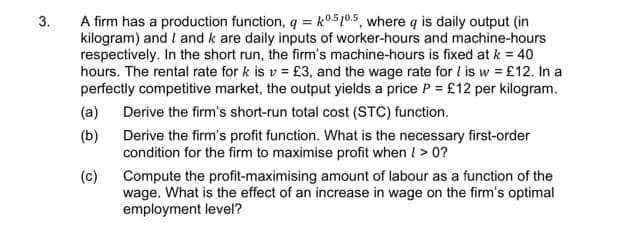3. A firm has a production function, q = k0.5 10.5, where q is daily output (in kilogram) and I and k are daily inputs of worker-hours and machine-hours respectively. In the short run, the firm's machine-hours is fixed at k = 40 hours. The rental rate for k is v= £3, and the wage rate for I is w = £12. In a perfectly competitive market, the output yields a price P = £12 per kilogram. Derive the firm's short-run total cost (STC) function. (a) (b) (c) Derive the firm's profit function. What is the necessary first-order condition for the firm to maximise profit when /> 0? Compute the profit-maximising amount of labour as a function of the wage. What is the effect of an increase in wage on the firm's optimal employment level?
3. A firm has a production function, q = k0.5 10.5, where q is daily output (in kilogram) and I and k are daily inputs of worker-hours and machine-hours respectively. In the short run, the firm's machine-hours is fixed at k = 40 hours. The rental rate for k is v= £3, and the wage rate for I is w = £12. In a perfectly competitive market, the output yields a price P = £12 per kilogram. Derive the firm's short-run total cost (STC) function. (a) (b) (c) Derive the firm's profit function. What is the necessary first-order condition for the firm to maximise profit when /> 0? Compute the profit-maximising amount of labour as a function of the wage. What is the effect of an increase in wage on the firm's optimal employment level?
Chapter10: Cost Functions
Section: Chapter Questions
Problem 10.9P
Related questions
Question

Transcribed Image Text:3.
A firm has a production function, q = k0.5 10.5, where q is daily output (in
kilogram) and I and k are daily inputs of worker-hours and machine-hours
respectively. In the short run, the firm's machine-hours is fixed at k = 40
hours. The rental rate for k is v= £3, and the wage rate for I is w = £12. In a
perfectly competitive market, the output yields a price P = £12 per kilogram.
Derive the firm's short-run total cost (STC) function.
(a)
(b)
(c)
Derive the firm's profit function. What is the necessary first-order
condition for the firm to maximise profit when /> 0?
Compute the profit-maximising amount of labour as a function of the
wage. What is the effect of an increase in wage on the firm's optimal
employment level?
Expert Solution
This question has been solved!
Explore an expertly crafted, step-by-step solution for a thorough understanding of key concepts.
Step by step
Solved in 4 steps

Knowledge Booster
Learn more about
Need a deep-dive on the concept behind this application? Look no further. Learn more about this topic, economics and related others by exploring similar questions and additional content below.Recommended textbooks for you


Managerial Economics: Applications, Strategies an…
Economics
ISBN:
9781305506381
Author:
James R. McGuigan, R. Charles Moyer, Frederick H.deB. Harris
Publisher:
Cengage Learning

Exploring Economics
Economics
ISBN:
9781544336329
Author:
Robert L. Sexton
Publisher:
SAGE Publications, Inc


Managerial Economics: Applications, Strategies an…
Economics
ISBN:
9781305506381
Author:
James R. McGuigan, R. Charles Moyer, Frederick H.deB. Harris
Publisher:
Cengage Learning

Exploring Economics
Economics
ISBN:
9781544336329
Author:
Robert L. Sexton
Publisher:
SAGE Publications, Inc


